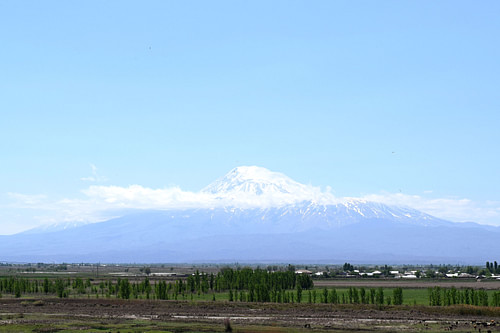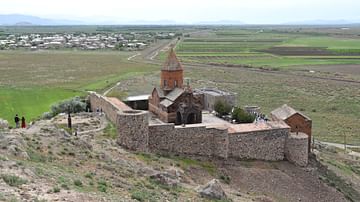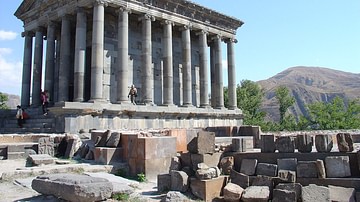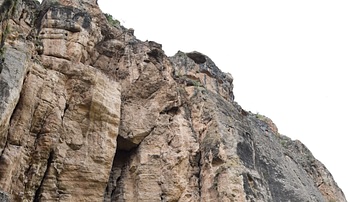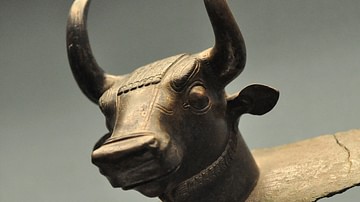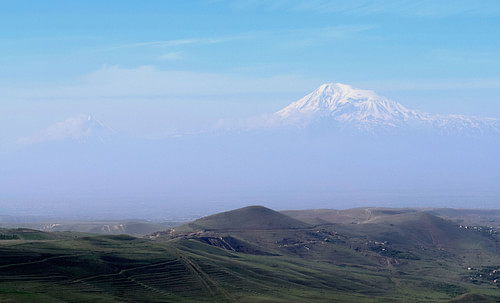
Mount Ararat (Armenian: Masis; Turkish: Ağrı Dağı; Kurdish: Çiyaye Agiri; Azeri: Ağrıdağ; Persian: Kūh-e Nūḥ) is a dormant, compound volcanic mountain, consisting of two ancient volcanic peaks, located in present-day eastern Turkey very close to the border with Armenia. Strongly associated with Armenian culture, mythology, and identity, Mt. Ararat is also where, according to some legends, Noah's Ark landed after the biblical flood.
Geography
Located roughly halfway between Lake Van to the southwest in Turkey and Lake Sevan to the northeast in Armenia, the Ararat Mountains dominate the Armenian Highlands. The Ararat Mountains are located within the southern end of the Ararat Plain, and they thus create a fertile agricultural zone with a temperate climate. Together, the Ararat Mountains straddle the borders of what are present-day Turkey, Armenia, Iran, and Azerbaijan. Mt. Ararat (“Greater Ararat”) rises to a height of 5,137 m (16,854 ft). Mt. Ararat's neighboring mountain, Little Ararat (“Ararat the Lesser”) rises upwards to 3,925 m (12,877 ft). Mt. Ararat and Little Ararat are the highest and sixth highest points in Turkey. On a clear day, both can be seen from downtown Yerevan, Armenia, which is 54 km (33 mi) away from Mt. Ararat. The monastery Khor Virip additionally affords stunning views of the Ararat Mountains from Armenia.
Ancient Myths & Legends
In ancient times, successive Mesopotamian peoples regarded the mountains as sacred, but they were also wary of the fierce, local inhabitants. The Sumerians, Akkadians, and Assyrians each believed that Mt. Ararat was not only the home of their gods, but also the source of their civilizations, as the waters of the Tigris and Euphrates Rivers flowed downwards from the mountain to fertilize the lands adjacent to their cities and settlements. Assyrian texts, in particular, praise the holiness and majesty of the mountains, describing them as a place where “heavenly birds cannot reach.”
Mesopotamians, however, also associated the mountains with the fierce tribes that inhabited Mt. Ararat's slopes; regularly, they raided Mesopotamian villages and settlements. Another perceived danger associated with Mt. Ararat was that of disastrous flooding. Sumerians, Akkadians, and Babylonians each had their own flood account, but they all in turn referenced the Mountains of Ararat as the place in which their respective heroes found refuge after surviving torrential rains and perilous waters. An ancient Akkadian tale from the 3rd millennium BCE delineates the exploits of a man called “Utnapishti” who became immortal and survived a catastrophic flood by landing his vessel upon the tallest mountains in the north of his country. Gilgamesh, the celebrated Sumerian hero, reached a northerly mountain called “Mashu,” which was the location through which the sun rose and set every day.

Ancient Armenians called the mountain “Azatn Masis,” which meant “holy” and “free” in the Old Armenian language. Kajs, which were guardian spirits of royal and noble families, dwelled on Greater Ararat. Pagan Armenians found it taboo to scale the mountains as they believed, much like the Sumerians, that Mt. Ararat was the place where the sun came to rest during the night. Even after their conversion to Christianity, Armenians were still reluctant to risk climbing to Mt. Ararat's peak. There is, nevertheless, a legend that King Trdat III, Armenia's first Christian king, climbed Mt. Ararat to bring down stones for the foundations of eight new churches.
Armenians have many myths and legends about the base of the Ararat Mountains, many of which predate Christianity, and include dragons, snakes, and other reptilian monsters. These myths and legends are strongly correlated with the volcanic steam, ash, and black waters that spewed forth out of Mt. Ararat during eruptions and earthquakes. Movses Khorenatsi (c. 410-490s CE), an Armenian historian and the author of the History of Armenia, wrote that Armenians are the direct descendants of Noah through his son Japheth, and that Haik, the mythical founder of Armenia and ancestor to all Armenians, established his nation within the vicinity of Mt. Ararat.
Mt. Ararat in Scriptural & Historical Texts
There is much historical speculation as to when and how the biblical story of Noah and the great flood first became associated with Mt. Ararat. Some linguists contend that “Ararat” is merely a variation of “Urartu,” which was the leading ancient polity to the north of Assyria during the Iron Age. The Hebrew Book of Jubilees composed around c. 100 BCE, related that Noah's Ark was located on "Mount Lubar" in "the land of Ararat." (Jubilees 5.28, 10.15). The Jewish historian Flavius Josephus (37-100 CE) used the "Ararat" to denote a mountain south of Lake Van, but he subsequently attested traditions that Noah's Ark came to rest on "Mount Baris." (Jewish Antiquities 1.93)
In ways similar to the older Mesopotamian myths and legends, the Bible references the Mt. Ararat in Genesis 8.4 in relation to the story of Noah:
...And the ark rested in the seventh month, and on the seventeenth day of the month, upon the mountains of Ararat.
The Qu'ran is explicit in naming the mountain upon which Noah's ark landed as “Mt. Judi” and not Mt. Ararat:
A voice cried out: 'Earth, swallow up your waters. Heaven, cease your rain'. The floods abated and His will was done. The ark came to rest upon al-Judi, and a voice declared: 'Gone are the evil-doers'. (11:43)
The Arab geographer Ibn Khordadbeh (c. 820-912 CE) and the Arab historian Abu al-Hasan 'Ali al-Masudi (c. 896-956 CE) both asserted that the ark came to rest in in "Assyria", not too far from one of the sources of the Tigris River.
Previously it was thought by some historians that the presence of Jews in Armenia's Araxes Valley might have provided the catalyst in the reassociation of Mt. Ararat with Noah's Ark, but this assertion seems improbable. Just like historians throughout early medieval Europe (c. 400-1000 CE), early Armenian historians opined that the biblical Ararat was located in the ancient province of Corduene (Armenian: Korduk), situated to the southeast of Lake Van. Today this area is part of modern Turkey, and close to the source of the Tigris River and the city of Cizre. The arrival of European crusaders and intermarriage between Armenians and European crusaders in the 11th and 12th century CE seem to have accelerated the reassertion that Mt. Ararat was the spot where the Ark came to land. When Europeans returned to continental Europe from the Holy Land or Armenia, they reiterated that Mt. Ararat, located in the heart of Armenia, was where the ark could be found. It is worth noting that in later times, Mt. Ararat marked the frontier between Turkey and Iran between c. 1600-1800 CE.
Association with Armenian People & Culture
For thousands of years, the Armenian people have utilized the Ararat Mountains as emblems of their national and cultural identity. Appearing frequently in modern material culture - on everything from t-shirts and bumper stickers to wooden sculptures and necklaces - Mt. Ararat has also graced Armenian currency, stamps, and its three coats of arms since 1918 CE. Although Armenians see Mt. Ararat as a symbol for their deep losses and tragedies in the 20th century CE as it currently lies within the borders of Turkey, they also view the mountains as intricately connected to their faith, religious beliefs, and artistic traditions.
This article was made possible with generous support from the National Association for Armenian Studies and Research and the Knights of Vartan Fund for Armenian Studies.
